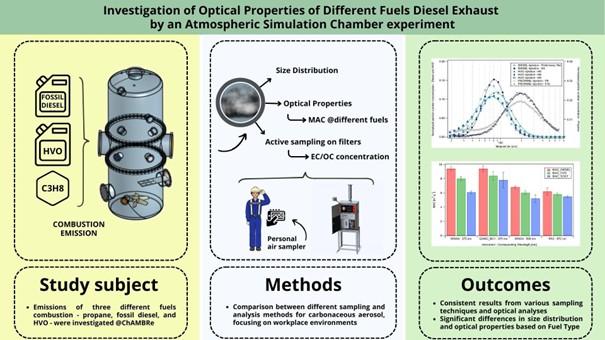The study “Measurement report: Investigation of optical properties of carbonaceous aerosols from the combustion of different fuels by an atmospheric simulation chamber” has been published in Atmospheric Chemistry and Physics. It was conducted by PM_TEN as part of the CALIPSO project, with support from the Environmental Physics Laboratory (labfisa) research group at the Department of Physics, University of Genoa, and INFN.
Analysis of Diesel Emissions
The research examined emissions from diesel engines, comparing the carbonaceous particulate matter generated by the combustion of commercial diesel and HVO. Among the parameters analyzed, particular attention was given to the carbonaceous components of the emitted particles — specifically elemental carbon (EC), organic carbon (OC), and black carbon (BC) — key elements for assessing the environmental and health impact of emissions.
Properties of Carbonaceous Aerosols and Environmental Implications
Experiments conducted in the ChAMBRe atmospheric simulation chamber enabled a detailed study of the chemical-physical and optical properties of freshly emitted carbonaceous aerosols, highlighting how these vary significantly depending on fuel type and combustion conditions.
The study also tested various samplers and analytical techniques commonly used in occupational and environmental exposure monitoring, demonstrating their reliability in detecting consistent concentrations of the pollutants under investigation.
This research provides a valuable reference framework for describing the diversity of diesel engine emissions, contributing to the development of effective strategies for protecting health and the environment, and to a deeper understanding of the mechanisms that govern air quality and public health.
Read the full article: https://acp.copernicus.org/articles/25/9387/2025/

